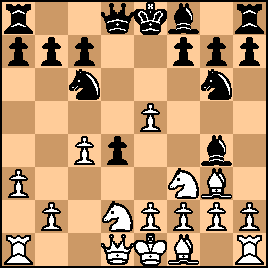| KEG: This game was, as <knight> suggests, pretty much about one move (17...Bb4+?) after which Mieses was pretty much lost. And after 18...Bd6?, the wrap-up was child's play for Pillsbury. I also agree that before his 17th move blunder, Mieses had decent chances with Pillsbury reduced to the sort of cramped position he rarely let himself get as White. But it must be recalled that Pillsbury had an extra pawn and only got somewhat the worst of the position with his weak 16th move. But Mieses' edge was fleeting, and Pillsbury pounced when given the chance. 1. d4 d5
2. c4 e5
The Albin-Counter Gambit which was popular at the time. 3. dxe5 d4
When the same players crossed swords at Monte Carlo 1903, Mieses (in his game as Black against Pillsbury) played 3...dxc4 here (and lost that game as well). 3...d4 is far more popular, but both moves are playable and both leave White with the edge. 4. Nf3 Nc6
5. a3

click for larger viewThe soundness of this move was questioned by Sergeant-Watts in their commentary on this game, but both that and 5. g3 are the most popular lines, and the text--preparing both attack and defense on the Queen-side--looks quite good. Another good option is 5. Nbd2 as recommended by Sergeant-Watts. 5... Bg4
The most aggressive choice, as would be expected from Mieses. Soundest is probably 5...Nge7 or maybe 5...g6 or 5...Bf5. As a practical matter, Pillsbury got flustered by 5...Bg4 and soon relinquished the edge he had enjoyed because of his extra pawn. 6. Bf4
Playable, but 6. Qb3 or 6. Qd3 or 6. h3 or 6. Nbd2 all seem better ways for White to retain his advantage. 6... Nge7
7. Nbd2 Ng6
8. Bg3

click for larger viewA double-edged position which generally suited the styles of both Pillsbury and Mieses. White was still somewhat better with his extra pawn compensating for his shut-in light-square Bishop. 8... a5?!
"With a view to Bc5." (Sergeant-Watts)
"To prevent b4 and make Bc5 possible) (Hoffer/Bachmann). 8...Qd7 or 8...Qe7 were sounder, but the text had the virtue of putting Pillsbury on the defensive, and for once he faltered. 9. h3
Weakening and loss of time (since Pillsbury played h4 three moves later). 9. h4 or 9. Qa4 were better and what I would have expected from Pillsbury. 9... BxN
10. NxB
Pillsbury could have avoided a lot of grief with 10. exB. His game now became increasingly cramped. 10... Bc5
All according to plan.
This left:

click for larger viewNot a very Pillsbury-like opening formation as White. White's bottled up f1 Bishop is an eye-sore. Pillsbury obviously was not comfortable handling this set-up and soon found himself with a small disadvantage despite his extra pawn. He could not have had any inkling at this point of the fireworks that would yield him a won game within the next seven to eight moves. | 




